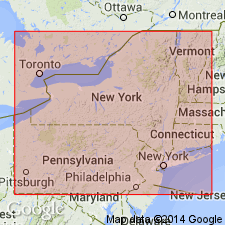
- Usage in publication:
-
- Mount Marion beds
- Modifications:
-
- Named
- Dominant lithology:
-
- Shale
- Sandstone
- AAPG geologic province:
-
- Appalachian basin
Summary:
Name Mount Marion beds is here proposed for the lower fossiliferous Hamilton beds of Ulster Co. region. Underlie Ashokan beds, the terminal phase of the Hamilton in the region. Age is Middle Devonian.
Source: GNU records (USGS DDS-6; Reston GNULEX).
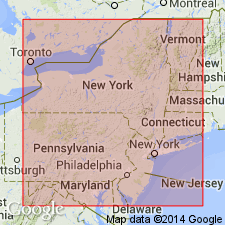
- Usage in publication:
-
- Mount Marion beds
- Modifications:
-
- Overview
- AAPG geologic province:
-
- Appalachian basin
Summary:
Mount Marion beds consist of marine shales and sandstones, 400 to 500 ft thick. They underlie, without break, the Ashokan formation and overlie "Marcellus" shales [named Bakoven shale by Chadwick, 1933]. Well exposed at Mount Marion, west of Saugerties.
Source: GNU records (USGS DDS-6; Reston GNULEX).

- Usage in publication:
-
- Mount Marion sandstone
- Modifications:
-
- Revised
- AAPG geologic province:
-
- Appalachian basin
Summary:
Marcellus west of Catskill is divided into (descending) Mount Marion sandstone, 800 ft thick, and Chittenango black shale, 200 ft thick.
Source: GNU records (USGS DDS-6; Reston GNULEX).
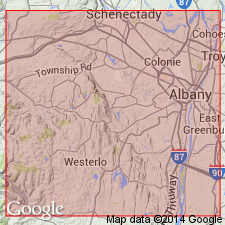
- Usage in publication:
-
- Mount Marion formation*
- Modifications:
-
- Overview
- AAPG geologic province:
-
- Appalachian basin
Summary:
In Albany Co., Mount Marion formation overlies Bakoven shale and underlies Ashokan formation. Consists of argillaceous sandstones and sandy shales, which are dark blue gray when fresh, and heavier sandstones. The heavier sandstones predominate in higher horizons and entire formation tends to weather to brownish color. Thickness over 1,400 ft. Age is Middle Devonian.
Source: GNU records (USGS DDS-6; Reston GNULEX).
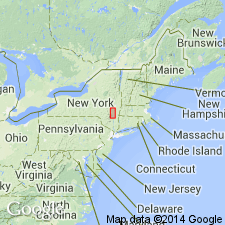
- Usage in publication:
-
- Mount Marion Formation
- Modifications:
-
- Revised
- AAPG geologic province:
-
- Appalachian basin
Summary:
Mount Marion Formation of Hamilton Group is divided into Berne and overlying Otsego Members. The boundary between the two members is revised in this report. The base of the Otsego is placed at the base of a coral-brachiopod biostrome, the lowest rugose coral in a massive sandstone or the top of the massive sandstone (in the absence of corals). In the absence of both, the base is placed at the lowest shell-bed-rich shales that overlie an 8.0-m-thick package of thin sandstones and shales. The base is somewhat diachronous due to local erosive beveling. Formal names are proposed here for four key beds within the Formation: the Dave Elliott occurs in the upper part of the Berne Member; the Halihan Hill Bed marks the base of the Otsego; and the Katsbaan and Timmerman Hill Beds occur in the lower part of the Otsego.
Source: GNU records (USGS DDS-6; Reston GNULEX).
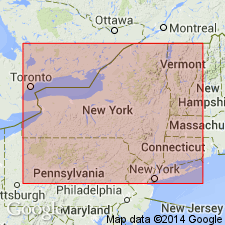
- Usage in publication:
-
- Mount Marion Formation
- Modifications:
-
- Revised
- AAPG geologic province:
-
- Appalachian basin
Summary:
Marcellus Formation will be "formally" raised to subgroup status within the Hamilton Group and be divided into a lower Union Springs Formation and an upper Mount Marion Formation (in eastern New York), and an upper Oatka Creek Formation (in central and western New York), in a publication by Ver Straeten and others (in prep). Union Springs Formation will incorporate three members across New York: the Bakoven Member (geographically extended across the State of New York), the Stony Hollow Member (restricted), and the Hurley Member (new). The Hurley underlies the Cherry Valley Member at the base of the laterally equivalent Mount Marion and Oatka Creek Formations. The Cherry Valley is expanded to include equivalent strata in eastern New York formerly placed in the upper part of the Stony Hollow Member. The revised Cherry Valley is composed of two lithosomes: an eastern sand-dominated facies and a central to western carbonate-dominated facies.
["Subgroup" not recognized as a formal stratigraphic rank term (CSN, 1933; ACSN, 1961, 1970; NACSN, 1983, 2005, 2021). Considered informal and should not be capitalized.]
Source: Modified from GNU records (USGS DDS-6; Reston GNULEX).
For more information, please contact Nancy Stamm, Geologic Names Committee Secretary.
Asterisk (*) indicates published by U.S. Geological Survey authors.
"No current usage" (†) implies that a name has been abandoned or has fallen into disuse. Former usage and, if known, replacement name given in parentheses ( ).
Slash (/) indicates name conflicts with nomenclatural guidelines (CSN, 1933; ACSN, 1961, 1970; NACSN, 1983, 2005, 2021). May be explained within brackets ([ ]).

